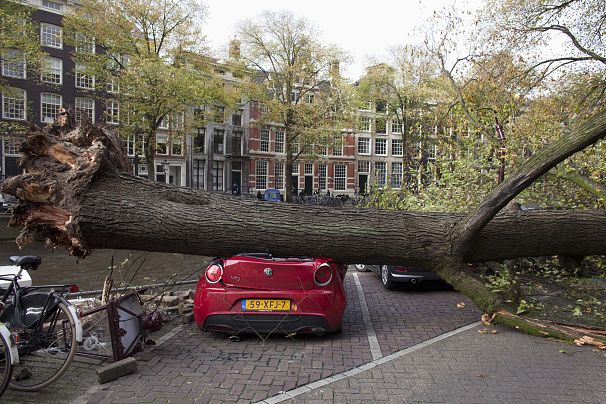As Storm Eleanor winds down after thrashing the European continent this week, Euronews examines the history of storm naming, and reveals how you can get involved as well.
Storm Eleanor has wrought havoc in Europe. Its intense flooding, gales and strong winds which swept Ireland, the UK, France and Spain this week has left hundreds of thousands without power, and at least four people dead in separate incidents.
Before Eleanor, there was Dylan, Cermen, Herwart, Ophelia, Aileen and many more, but it is only by naming these storms that we can identify them internationally.
Who names our storms?
Storm have been named in Europe for centuries. A powerful storm labelled ‘Ulysses’ reportedly swept Ireland in 1903, uprooting thousands of trees and damaging entire buildings in just one night.
Severe weather systems in Europe would be christened after the person who spotted them, after the saint’s day of their occurrence, or by the public. As of 2002, weather buffs in Germany can submit name suggestions for storms for a small fee as part of an international scheme.
But it is only recently that Europe has established formal naming systems to reduce confusion.
Denmark, Sweden and Norway’s meteorological services began the practice after a deadly extratropical cyclone lashed the region in 2013, but was dubbed as the October storm, St Jude, Christian, Simone and Allan and by different countries.
"There was more confusion and it’s come to the fore with social media in the last five years," says Envelyn Cusack, who chairs the Working Group for the Cooperation between European Forecasters (WCGEF).
"It wasn’t really an issue before."
In central Europe, the UK Met Office and Ireland’s Met Éireann piloted their naming project in 2015, and France, Spain and Portugal thereafter in December. Both Belgium and the Netherlands are in talks to join the two groups, but a universal naming system is yet to be rolled out across the continent.
"The national meteorological services in Europe want to be the authoritative voice and take control of storm naming in order to make our storm warnings more effective for European citizens", says Envelyn, "because up to now, storms could have had three or four different names in the media."
"But there are separate storms in the Mediterranean and they would never come towards Ireland for example, so we want each country to be in a cluster based on their meteorology.
"Within the next year or two, we hope that most countries in the EU will become part of these groups to help create a more unified system."
Why it’s important
Surveys have shown that storm naming can increase the reach of official warnings and encourage preparedness before they hit.
Derrick Ryall, head of public weather services at the Met Office, said in September: “Naming storms has been proved to raise awareness of severe weather in the UK, crucially prompting people to take action to prevent harm to themselves or their property.”
How they are named
Only storms that prompt an Amber “be prepared” or Red “take action” warning will be christened with their own title in the UK and Ireland, and the impact of wind, rain and snow will be taken into account.
Each year, 21 names are compiled from suggestions by the public—Storm Abigail was the first to be named under this system in 2015—and the gender of the first storm alternates at the beginning of each season which starts in September. Each new storm is also named alphabetically, but ‘Q’, ‘U’, ‘X’, ‘Y’ and ‘Z’ are excluded since few names begin with those letters.
In Germany, however, The Institute for Meteorology of the Free University in Berlin sells storm-naming rights to members of the global public via their ‘Adopt a Vortex’ programme. A €238 fee is charged for name suggestions chosen. Storms are named alphabetically throughout the year from A to Z and are published on official weather maps for wider use.












